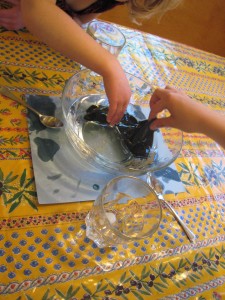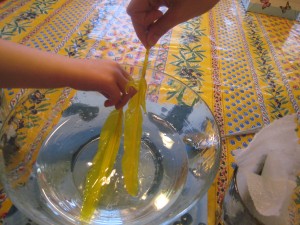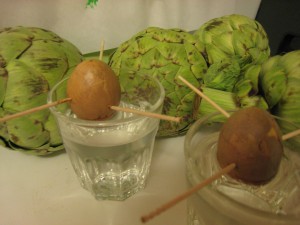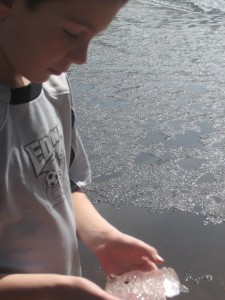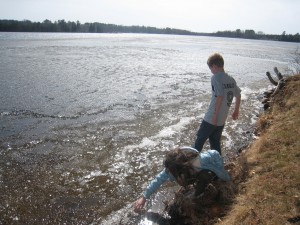Tag: kids’
We are the Whales
- by KitchenPantryScientist
Whale hunting has been in the new a lot recently, but it now appears that the biggest threat to these intelligent, majestic animals is no longer whalers’ harpoons.
I read this morning in the Star Tribune that “Sperm whales, feeding even in the most remote reaches of Earth’s oceans, have built up stunningly high levels of toxic and heavy metals.” Most of these contaminants have been introduced into the ocean by humans of course. The article goes on to talk about how our food supply is being threatened by our poisoned oceans and that seafood is a primary source of protein for over 1 billion people. Do you eat fish?
Apparently, high concentrations of these poisons collect in these whales because they are at the top of the food chain. That means they eat fish and squid that have eaten smaller animals, which have eaten yet smaller animals and plants and so on. Humans are also at the top of the food chain, and although we don’t only eat contaminated fish, we eat many other plants and animals that are exposed to heavy metals, pesticides and herbicides. Both whales and humans nurse their young, passing contaminants from mother to baby. (That beautiful piece of wild salmon may not be as pristine as you’ve convinced yourself that it is. Like it or not, our bodies are full of toxins too.)
What’s happening to the whales is happening to us. The difference is that the whales are not the ones polluting the world.
Look at the Gulf. Looks at our sick oceans. Go read “The Lorax.”
We have to save the whales to save ourselves.
Static Fun
- by KitchenPantryScientist
It’s been raining for about two weeks straight in Minnesota and my kids are climbing the walls. Yesterday, they built an amazing fort and played in it for an hour before they came to me asking what they could do next.
This easy experiment kept them busy for a little while.
Take a plastic comb and comb your hair a number of times, or rub it on some tissue paper. Tiny charged particles called electrons will collect on the comb and give it a negative charge.
Now, run a very thin stream of water from a faucet and hold the comb next to it without actually touching the water. What happens?
The stream of water is positively charged and is attracted to the opposite (negative) charge of the comb, pulling and bending the stream of water toward the comb.
Pretty cool.
Many more experiments to follow in the next few months! We’re planning a summer of science between our many sporting activities, so get those science notebooks ready and follow along with us!
Oil Spill Experiment Revisited
- by KitchenPantryScientist
I first posted this experiment on May 5, certain that the spill would soon be contained. Now we know it’s worse than we imagined and no immediate solution is in sight. If your kids don’t understand why it’s so hard to help the birds, have them try this project.
The oil spill in the Gulf of Mexico is devastating news to the already fragile and damaged ecosystems in the area. To demonstrate how hard it is to remove oil from water, and what materials work best, I found this experiment online at tryscience.org and decided to have my kids try it. It was messy and disgusting and oil got all over everything. In other words, it was a great demonstration of how hard it will be to clean up the mess made by BP’s Deepwater Horizen oil rig, which exploded on April 20th.
You’ll need a clear bowl, water, yellow oil (vegetable, corn or canola will work,) cotton balls, cheese cloth, polyester cloth (the website said polypropylene, but I couldn’t find any,) feathers, and a spoon.
Put some water in the bowl and pour in some oil. I probably added a cup so it would cover the water. Then, using spoons and the other materials, try to remove the oil from the water. What works best?
We put our feathers in oil and then tried to clean them off using dish soap and water, which is how they clean off marine birds covered with oil following oil spills.
Polypropylene is a synthetic material made from Carbon and Hydrogen, the same elements in oil. Oil is attracted to polypropylene, and both float on water, so polypropylene is often used in cleaning up oil spills. You can also find it in gloves and sock liners.
If one cup of oil is this hard to clean up, can you imagine the mess pouring into the Gulf of Mexico right now, at the rate of about 210,000 gallons a day (according to the New York Times.) Here is a link to a map that is tracking the spill.
Butterfly Season
- by KitchenPantryScientist
met⋅a⋅mor⋅pho⋅sis
| Biology. a profound change in form from one stage to the next in the life history of an organism, as from the caterpillar to the pupa and from the pupa to the adult butterfly |
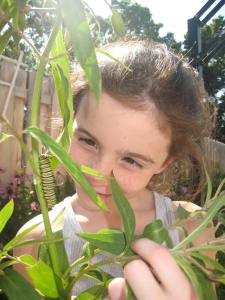
There are few things more magical than watching a caterpillar turn into a chrysalis and then a butterfly. It’s the beginning of butterfly season, and soon you’ll be able to find monarch caterpillars on milkweed. Just this morning, I spotted a Tiger Swallowtail butterfly by the lake. Not only is it fascinating to observe metamorphosis, it is a great opportunity to create some fantastic artwork for your science notebook!
When the weeds in your area start to get big, take a trip to a park, or a farm, or even a weedy lot and search for some milkweed. (See photo below.) Look carefully on the plants, and there’s a good chance you’ll find a Monarch caterpillar like the one my daughter is watching at in the photo at the top of this page. If you find another type of caterpillar, take whatever plant you find it on with you as food. Carefully take the caterpillar and plenty of milkweed and place them in a large see-through container. We used an old plastic pretzel container, but a large jar or Tupperware container would work too. Just be sure to punch air holes! I put the milkweed in a little vase with water to keep it alive, but a friend told me you can put the leaves between damp paper towels and keep them in the fridge, getting them out when you need fresh ones.

milkweed
Last year, I planted butterfly weed, a type of milkweed, in our garden in hopes of getting caterpillars right in our own backyard and it worked! Just plant milkweed or other butterfly-friendly plants this spring and summer if you want a butterfly gardenof your own. It’s a great way to help the butterfly population. Swallowtail caterpillars like dill and I’ve seen caterpillars in my parsley too!
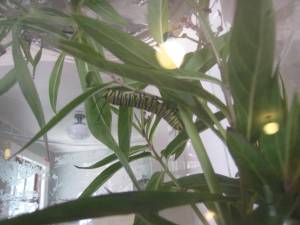
Once you have your caterpillar, all you have to do is make sure it has plenty of leaves to eat. Occasionally, you’ll have to dump out the caterpillar poop, of which there is a surprising amount. Get out your science notebook or just some paper and draw the caterpillar and the milkweed. When it is ready to form a chrysalis, the caterpillar will hang upside down and look like the letter J. Draw the chrysalis, and finally, the beautiful butterfly that emerges! Keep track of how the caterpillar is growing and how long it spends as a crysallis before hatching.
A few years ago, my kids and I were lucky enough to see the caterpillar turn into a chrysalis. It only takes a few seconds and is easy to miss, but it is truely amazing. If you’re lucky and patient, you may see it too. Here is a link to a short video showing what happens.
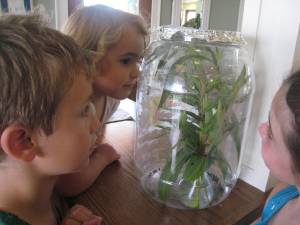
There’s nothing quite like taking the lid off your butterfly house and watching a Monarch soar away into the sky.
Avocado Sprouts
- by KitchenPantryScientist
When I was mashing up avocados with lime juice and salt the other day to satisfy my craving for guacamole, my kids asked if they could keep the pits. I suggested we sprout them and showed them how to poke toothpicks into the pits and balance them in a glass of water with the pointed end up and the round end sitting in the water. I had no idea that our little experiment would send me on a trip down memory lane.
As a kid, I spent my summers living in California while my dad did research at a physics laboratory in the Bay Area. Around 1976, we spent an entire year there when my dad took a sabbatical. We rode the ferry to Sausalito, feasted on hot fudge sundaes at Ghiradelli square and sat on the Berkeley pier eating clam chowder from Spanger’s. Every summer, we took backpacking trips along the coast of Point Reyes, fished in the Truckee river near Lake Tahoe and explored the High Sierras. I was a lucky kid.
The funny thing is, what I remember as clearly as all those adventures is that we almost always had an avocado seed sitting in our kitchen window and now, every time I look at our science experiment, I think about my mom and the summers of my youth. Maybe I’ll try to keep an avocado pit growing in my kitchen from May to August so that some day, one of my kids will show their own children how to sprout an avocado pit and remember our summers together.
Fizzy Balloons
- by KitchenPantryScientist

I was never an enthusiastic chemistry student. That being said, I have to admit that chemical reactions can be lots of fun to watch as things turn colors, make bubbles, or smell different. They can change from liquids to solids and they can even explode.
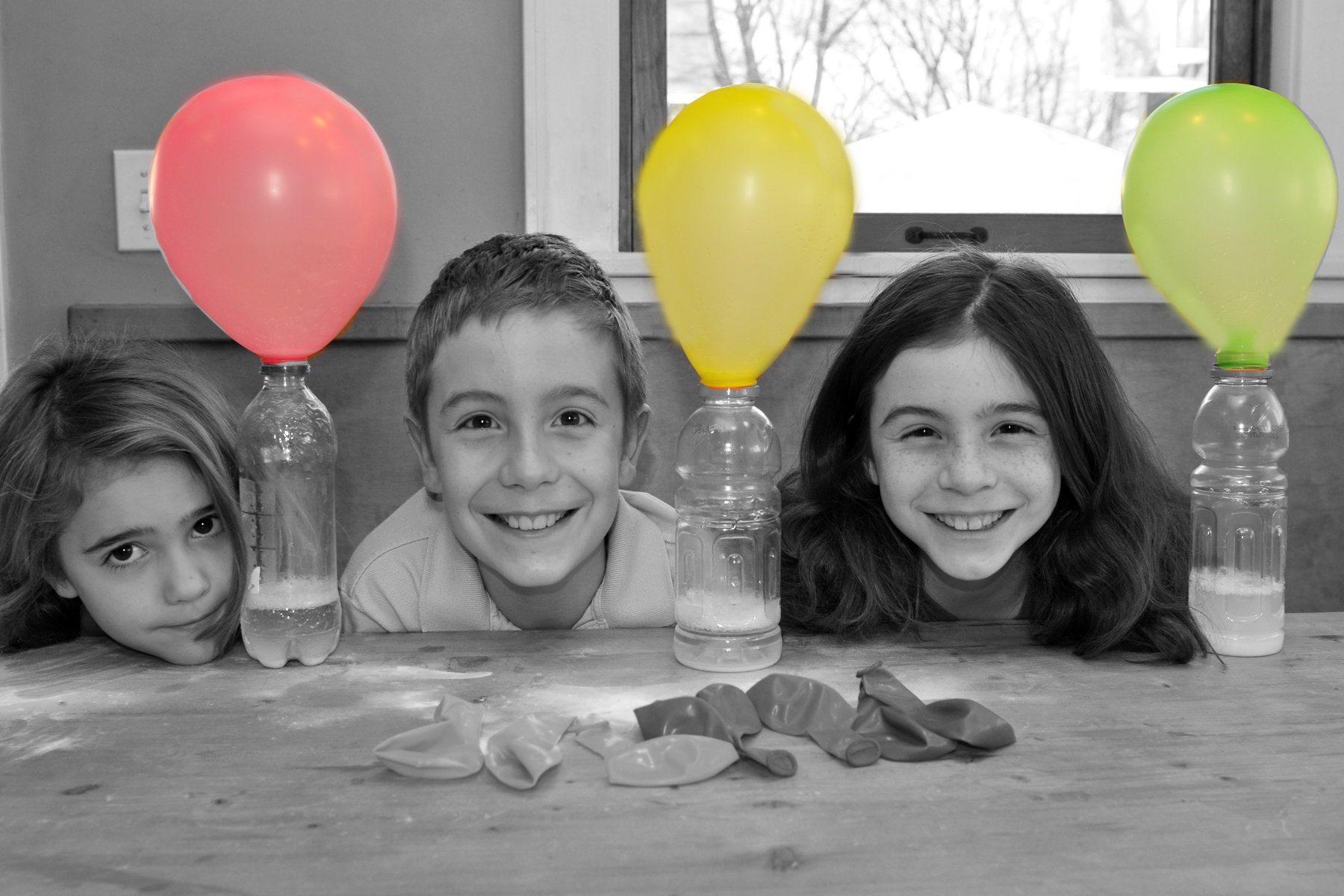
There are many fun, safe chemical reactions you can perform with your kids. I’d recommend having them put on safety goggles or sunglasses, if you have them, for most experiments where you mix things together. As you can see, my children aren’t wearing any eye protection for this project, but I did have them stand back to make sure the balloon wouldn’t explode the first time we did it. Just use common sense.

You will need: a balloon, an empty soda bottle, white vinegar, and baking soda. Put 1/4 to 1/2 cup vinegar into the soda bottle. Then, hold the mouth of the balloon open and have your child pour about a teaspoon of baking soda into the balloon. Shake the soda into the “bulb” or the main part of the balloon. Then, stretch the mouth of the balloon over the mouth of the bottle, trying to keep the main part of the balloon off to the side (so the soda isn’t dumped into the bottle right away.) Ask them what they think will happen when you mix the two things together. Finally, let your child shake the soda into the bottle, all at once.

Stand back and watch what happens!
If the seal is tight, which it should be, the reaction between the soda and the vinegar will form a gas that inflates the balloon. Our balloon was big enough that it didn’t explode, but if your balloon is over-inflating, simply take it off of the bottle. Just pay attention and you’ll be fine.
What happened?
Baking soda is a chemical called sodium bicarbonate. Vinegar is called acetic acid. These two chemicals react to form some different chemicals. One of these is carbon dioxide gas. This is called a chemical reaction. The gas is what inflates the balloon. We know a reaction is happening because we can see bubbles forming.
What else do your kids notice about the reaction? Have them record (or help them to record) what they see in their science notebooks. Older kids can draw what they see and then try to describe it. My kids loved it when I wrote down their descriptions for them before they could write. Have them touch the bottle. Does it feel warmer or cooler than room temperature? A temperature change is also a clue that a chemical reaction is occurring! They could even time how long it takes for the balloon to inflate.
My kids did this experiment three times and would have kept doing it all day. They thought it was pretty great. Give it a try! Put those budding brains to work!
Oil Spill Experiment
- by KitchenPantryScientist
The oil spill in the Gulf of Mexico is devastating news to the already fragile and damaged ecosystems in the area. To demonstrate how hard it is to remove oil from water, and what materials work best, I found this experiment online at tryscience.org and decided to have my kids try it. It was messy and disgusting and oil got all over everything. In other words, it was a great demonstration of how hard it will be to clean up the mess made by BP’s Deepwater Horizen oil rig, which exploded on April 20th.
You’ll need a clear bowl, water, yellow oil (vegetable, corn or canola will work,) cotton balls, cheese cloth, polyester cloth (the website said polypropylene, but I couldn’t find any,) feathers, and a spoon.
Put some water in the bowl and pour in some oil. I probably added a cup so it would cover the water. Then, using spoons and the other materials, try to remove the oil from the water. What works best?
We put our feathers in oil and then tried to clean them off using dish soap and water, which is how they clean off marine birds covered with oil following oil spills.
Polypropylene is a synthetic material made from Carbon and Hydrogen, the same elements in oil. Oil is attracted to polypropylene, and both float on water, so polypropylene is often used in cleaning up oil spills. You can also find it in gloves and sock liners.
If one cup of oil is this hard to clean up, can you imagine the mess pouring into the Gulf of Mexico right now, at the rate of about 210,000 gallons a day (according to the New York Times?) I’m attempting to find out if there’s any way to help, aside from travelling to the area to help clean off wildlife by hand. As soon as I learn anything, I’ll post it here! Here is a link to a map that is tracking the spill.
FRESH
- by KitchenPantryScientist
 Happy Earth Day! This weekend, we planted a garden. Few things make me happier than watching my kids digging in the dirt, planting things. Maybe it’s because I come from a long line of farmers, or maybe it’s the sun-warmed, homegrown tomato I can almost taste just by thinking about it.
Happy Earth Day! This weekend, we planted a garden. Few things make me happier than watching my kids digging in the dirt, planting things. Maybe it’s because I come from a long line of farmers, or maybe it’s the sun-warmed, homegrown tomato I can almost taste just by thinking about it.
One of the most interesting books I’ve read recently is Michael Pollan’s “Omnivore’s Dilemma,” which follows four meals from field to table (from McDonald’s to foraging for mushrooms and hunting a wild boar.) It reminds the reader of how disconnected we have become from the sources of our food. One of my favorite parts of the book talks about Joel Saletin, who is a seminal figure in the sustainable agriculture movement and probably the most famous farmer in America. His bio on the FRESH movie website says:
“Joel calls himself a grass-farmer, for it is the grass that transforms the sun into energy that his animals can then feed on. By closely observing nature, Joel created a rotational grazing system that not only allows the land to heal but also allows the animals to behave the way the were meant to – as in expressing their “chicken-ness” or “pig-ness”, as Joel would say.”
This week, Joel is in town with Ana Joanes, who has made a documentary called “FRESH” that celebrates the farmers, thinkers and business people across America who are re-inventing our food system. It’s about food, but it’s also about economics, community and social justice. Last weekend, I was lucky enough to meet both Ana and Joel while volunteering at one of Joel’s lectures and was impressed with their optimism and sense of humor. Ana recently told planetgreen.discovery.com “I just had a little girl. Her name is Maayan. And, as clichéd as it may sound, I just want to do right by her. I don’t know what reality she’ll face when she reaches adulthood, but I’m trying my best so she doesn’t have to pick up the pieces of our recklessness and inaction.”
I saw FRESH last night in Minneapolis and loved it! The movie is just 70 minutes long, but you will want to talk about it for two hours afterwards! Tonight’s the last night it’s showing, so if you’re in the Twin Cities, don’t miss it! You can order tickets here.
The movie brings up interesting points about monocultures, antibiotic resistance, high fructose corn syrup, the corn industry (which my grandparents’ farm in Iowa is a part of,) and beneficial bacteria. I’m planning to explore many of these issues on this blog by writing a weekly post about food science between science experiments! Stay tuned!
Wonder
- by KitchenPantryScientist
I’m reading “Einstein’s God” by Krista Tippet right now, and came upon this great autobiographical account by Albert Einstein. It seems that he had a childlike wonder about the world that lasted well into adulthood and helped him to become a great thinker.
“Why do we come, sometimes spontaneously, to wonder about something? I think that wondering to one’s self occurs when an experience conflicts with our fixed ways of seeing the world. I had one such experience of wondering when I was a child of four or five and my father showed me a compass. This needle behaved in such a determined way and did not fit into the usual explanation of how the world works. That is that you must touch something to move it. I still remember now, or I believe that I remember, that this experience made a deep and lasting impression on me. There must be something deeply hidden behind everything.”
Krista then writes, “After seeing that compass, Einstein became mesmerized in turn by light and gravity. He spent his life seeking to comprehend the order “deeply hidden behind everything” and to describe it mathematically.”
What have you wondered about lately?
Lake Ice Going Out- Cool Crystals
- by KitchenPantryScientist
We were up at the lake last week when the ice went out. It was amazing. We arrived at noon to a lake whose surface was half covered with ice and woke the next morning to clear water. The wind was blowing the ice into shore and it broke into millions of crystals that sounded like a field of windchimes. The crystals were so sharp that our dog cut his foot.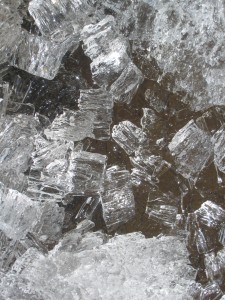
If you’re interested, you can watch the very wobbly, but cool video I took of the ice blowing around. You can see the ice crystals being pushed up and out of the water into piles. Listen, and you’ll hear the ice crystals clinking together!
[vsw id=”qt9HKExG2To” source=”youtube” width=”425″ height=”344″ autoplay=”no”]
This week, the kids and I are going to grow alum and sugar crystals, so be sure to check for the upcoming post!
